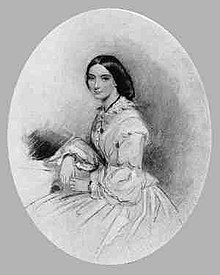Edward Daniel Stone (1832 – 17 September 1916) was an ordained deacon, classical scholar and a schoolmaster at Eton College.
Early life[edit]
He was the son of Lucia Catherine Stone (née Boswell) and Joseph Stone.[1] His siblings were Walter George Boswell Stone, an antiquarian; William Harry Stone, and Edith Stone.[2]
He attended Eton College beginning in 1845 and in 1856 he received a BA from King's College, Cambridge. Three years later he received his master's degree at Cambridge.[3][4] From 1855 until 1862, he was a Fellow of King's. In 1860, he was ordained a deacon of the Church of England.[1][3]
Career[edit]
Educator[edit]
Beginning in 1857, he was assistant master at Eton, a position he held for about 27 years.[3][4] His students included Sir Henry Babington Smith and Sir Evelyn Ruggles-Brise.[1] On 20 November 1873 he was admitted into the Chemical Society.[5]
Reilly stated that in 1884, he established a school in Broadstairs, Kent in Stone House and operated the school until 1895.[1][3][a] Stone moved to Abingdon, Berkshire after retirement in 1898, living with his son Rev. Francis Joseph (Frank) Stone, who was the Science Master at Radley College.[1][7]
Author[edit]
He was the author of The Field of Rivalry: An Heroic Poem, in four books, written in the 1850s.[3] Stone published Dorica, a volume of poems, four of which were in Dorset dialect. The volume was inspired by poet William Barnes.[8] In 1912, Stone published Herbert Kynaston: A Short Memoir with Selections from His Occasional Writings a memoir of Herbert Kynaston (1835 - 1910),[9] principal of Cheltenham College, canon of Durham Cathedral and professor of Greek at Durham University.[10]
Personal life[edit]

In August 1861, Stone married Elizabeth Theresa "Lily" Vidal.[11] Their ten children[1] included Lucy, Frank, Ned, Ruth, Mary, Margaret, William Johnson, Guy, Faith, and Christopher.[2] They adopted Nelly Stone.[12]
During his life, Stone corresponded with his son-in-law Compton Mackenzie.[2][13]
Stone died on 17 September 1916 in Abingdon and is buried in Radley at St. James's Churchyard.
Works[edit]
He was a Greek and Latin scholar. Among others he published:
- The Hannibalian Or Second Punic War, 1881
- Ionides: Exercises in Greek Iambics, 1883
- Dorica; (A Book of his Poetry) Kegan Paul, Trench & Co, 1888
- Selection from the Greek tragedians, 1890
- Tu Es Petrus. An Examination of Two Passages in S. Matthew's Gospel, and of the Doctrine of the Real Presence, 1909
- Florilegium Latinum; Translations Into Latin Verse, with Francis St John Thackeray, 1923
Notes[edit]
References[edit]
- ^ a b c d e f "Death of Mr. Stone: Schoolmaster, Poet, and Scholar". The Times. London. 19 November 1916. p. 20 – via newspapers.com.
- ^ a b c "Edward Daniel Stone Papers". CollectionsOnline Catalogue, Eton College. Retrieved 26 July 2017.
- ^ a b c d e Catherine Reilly (2000). Mid-Victorian Poetry, 1860–1879. A&C Black. p. 441. ISBN 9780720123180.
- ^ a b Eton College (1905). Eton College, Eton School Register Part II (1853-1859). Spottiswood, Privately Printed. p. vi.
- ^ The Chemical News and Journal of Physical Science, Volume 28. Griffin, Bohn and Company. 1873.
- ^ Home Beauties: As Communicated to the Author of the Imperial Guide, by Some of the Royal Family, the Nobility, Gentry, &c. for an Illuminated Appendix to that Work. C. Whittingham, printer. 1804. p. 36.
- ^ Radley College Register 1847 — 1904 (Second ed.). St. Peter's College, Radley. 1905. p. 16.
- ^ William Barnes (December 2013). Complete Poems of William Barnes: Volume I: Poems in the Broad Form of the Dorset Dialect. OUP Oxford. p. lxxvi. ISBN 978-0-19-956752-2.
- ^ Edward Daniel Stone (September 2010). Herbert Kynaston: A Short Memoir with Selections from His Occasional Writings (1912). Kessinger Publishing. ISBN 978-1-164-22458-7.
- ^ Lee, Sidney, ed. (1912). Kynaston, Herbert. Dictionary of National Biography 1912 Supplement. Vol. 2. London: Smith, Elder & Co.
- ^ J. C. Horner (1967). "Vidal, Mary Theresa (1815–1873)". Australian Dictionary of Biography, National Centre of Biography, Australian National University. Retrieved 27 July 2017.
- ^ Faith Compton Mackenzie (1938). As Much As I Dare - An autobiography. Collins 48 Pall Mall, London. pp. 100–111.
- ^ Robert Seymour Bridges and Lionel Muirhead (1984). The Selected Letters of Robert Bridges: With the Correspondence of Robert Bridges and Lionel Muirhead, Volume 2. University of Delaware Press. ISBN 9780874132045.